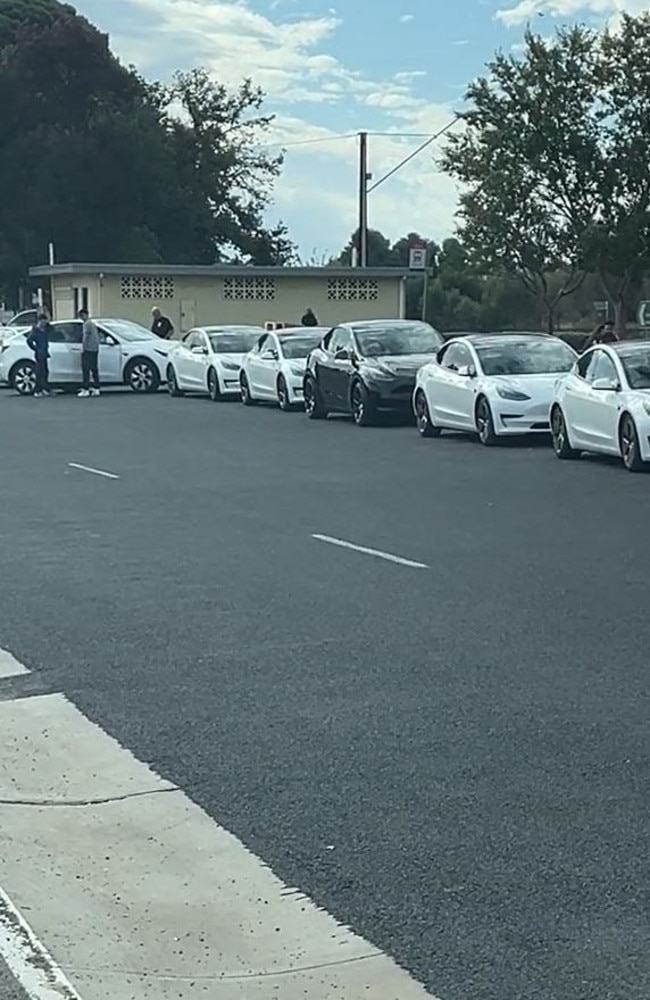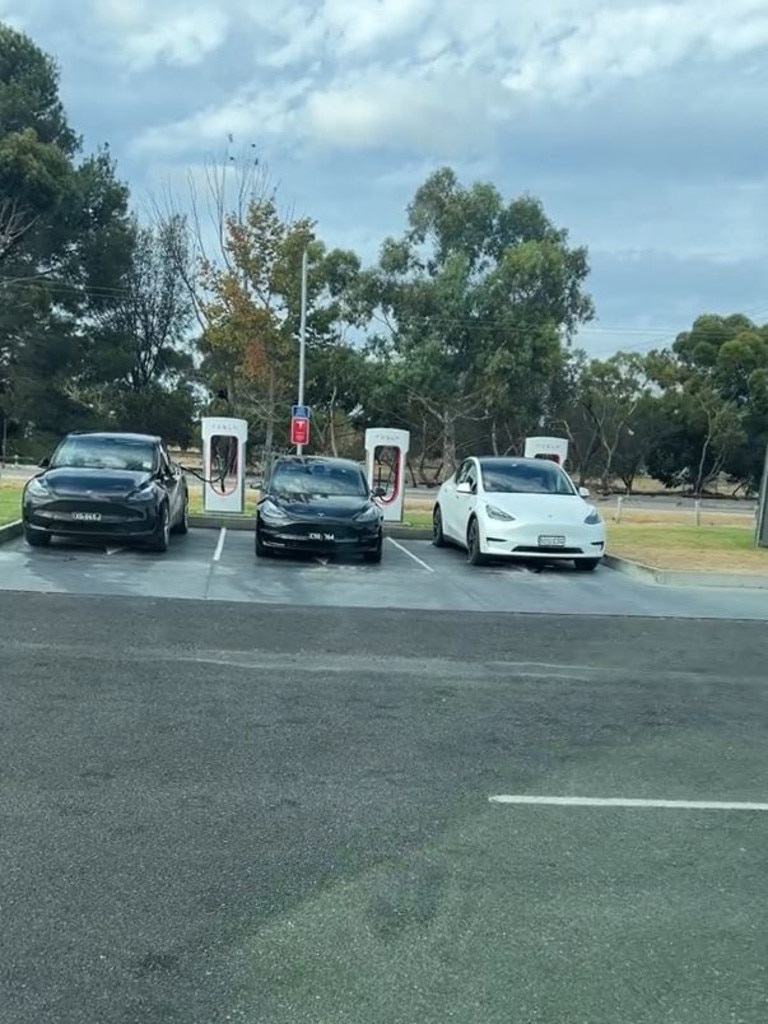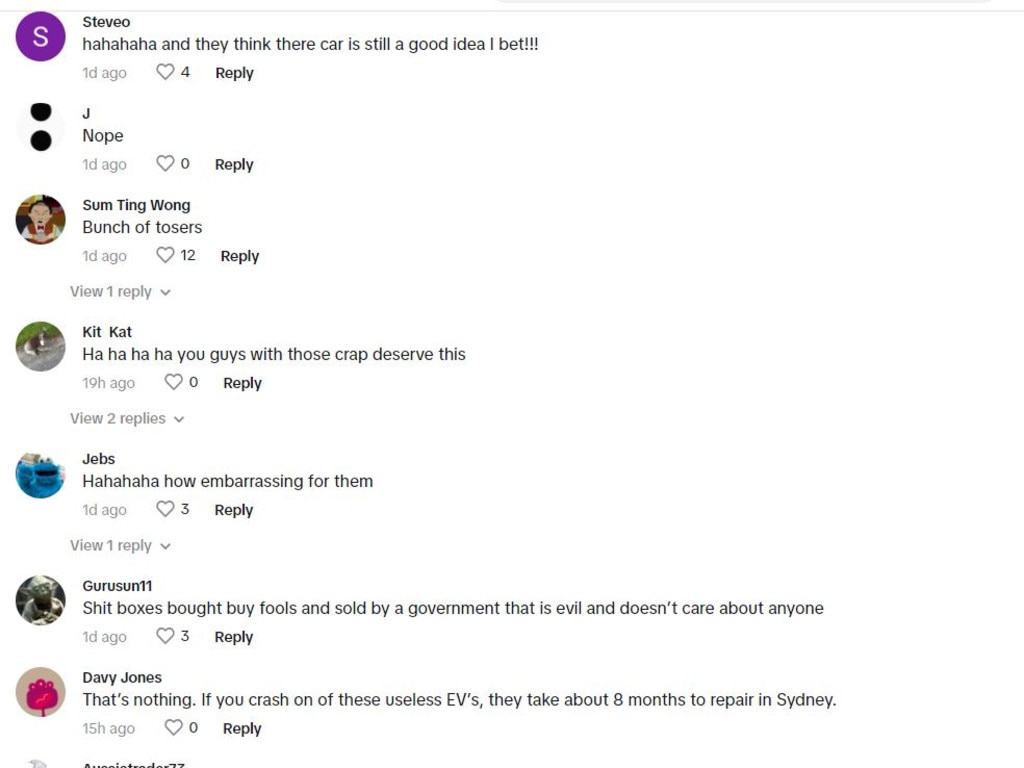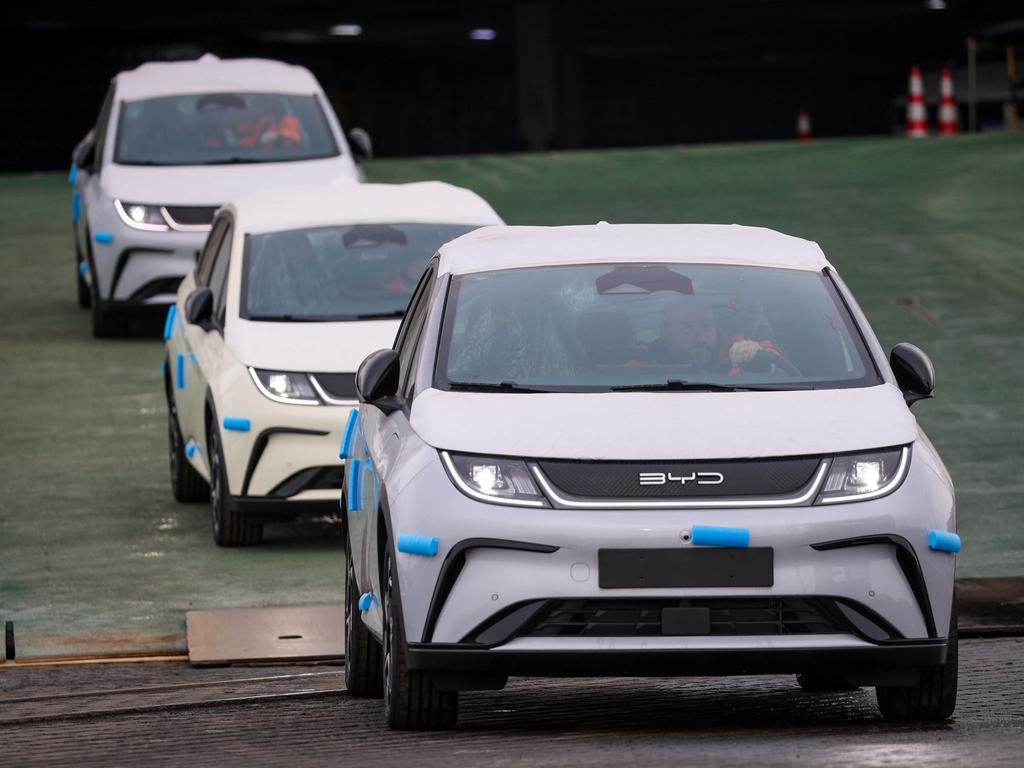Truth about ‘embarrassing’ photo of long queue of Teslas waiting to recharge
The sight of a long queue of Teslas waiting at a charging station sparked raucous ribbing online and gloomy headlines about the future of EVs.
It’s the jarring photo said to prove that Australia will struggle in its goal to ditch petrol cars.
But supporters of electric vehicles, a dozen of which are seen queuing for a spot at a charging station in the image in question, say it’s unfair to judge the convenience of EVs on one example.
Picked up by news outlets and shared widely on social media in the past day, the picture is actually a screenshot of a 10-second TikTok, uploaded on Tuesday.



It was reportedly filmed in Keith, a small town in South Australia with a population of 1130 people, sitting on the juncture of the Dukes and Riddoch highways about 220km southeast of Adelaide.
“Buy a Tesla they said,” it’s captioned, along with the hashtag #waitaminute and a crying face emoji.
The post was flooded with comments ranging from “they think there (sic) car is still a good idea I bet!” to “bunch of tosers (sic)” and “s*** boxes bought buy (sic) fools and sold by a government that is evil and doesn’t care about anyone”.
Swipe lacks context
Chris Jones, president of the Australian Electrical Vehicle Association, said an important piece of context missing from the clip was the fact it was shot during the Easter long weekend.
“Long weekends have always seen a spike in demand, which can put a strain on roadhouses, regardless of fuel source,” Dr Jones told news.com.au.
Four cars can be seen occupying charging bays while at least a dozen more are waiting.
It takes about 20 minutes for a Tesla to be adequately recharged at a supercharger, meaning a lengthy wait for those at the back of the queue.

While the long queue was a sign of improvements needed in the charging network, Dr Jones believes the benefits of owning an EV far outweigh the current inconveniences.
“The AEVA was always expecting EV sales to grow exponentially and that the need for inter-regional charging would grow along with it,” he said.
“We’re seeing new installations going in as fast as the networks will allow, so there will be some growing pains.
“It should be pointed out though that EV uptake will continue to grow independently of an expanded inter-regional fast charger network, simply because the vast majority of EV charging will take place at home, or at work during the week.
“So, despite some grumblings about having to wait in line on a busy weekend, all those EV drivers are still very happy with driving at a quarter of the cost of petrol.”
Network needs investment
There are an estimated 198,000 EVs on Australian roads but just 3000 public charging stations across the country.
“Naturally, the best solution to [queues] is more DC fast charging infrastructure along our busiest routes, and a high level of redundancy where possible,” Dr Jones said.
“The charging networks might do well to incorporate a ‘join queue’ feature for times like this, just to smooth things along.”
Data released at the weekend showed Australia is on track to double the number of charging stations over the coming year.
Almost 100 fast-chargers have opened since the start of the year alone, Minister for Climate Change and Energy Chris Bowen said.
“We’re working quickly to ramp up EV charging across Australia... with more fast charging added since the election than under the entire nine years of the previous government,” Mr Bowen said.

Last year, the Federal Government released its National Electric Vehicle Strategy – the framework behind its ambitious goal to cut new vehicle emissions by 61 per cent by the end of the decade.
Transport makes up 19 per cent of Australia’s total emissions, according to government data.
Passenger cars and light commercial vehicles alone contribute 60 per cent of transport emissions and more than 10 per cent of total emissions.

Part of the government’s plan to boost EV take-up is investing heavily in expanding public charging infrastructure.
So far it’s funded 117 chargers on major highways at an interval of 150km in partnership with NRMA, and invested another $78 million so the group can integrate regional communities into a national network.
It also offers an Electric Vehicle Discount, saving eligible buyers up to $11,000 a year.
“Our EV discount can make leasing EV’s and plug-in hybrids cheaper than leasing petrol vehicles in manycircumstances – a big reason why nearly 70 per cent of EVs on the road have been added since the election,” Mr Bowen said.
Various state governments have in place their own initiatives to boost EV uptake, from cash incentives to tax concessions.
Take-up growing sharply
A survey by Pulse Profile last year of motorists considering the purchase of a new car found access to public chargers was the second biggest barrier to opting for an EV, just behind price.
Despite that, 87,000 EVs were sold over the course of 2023, which is more than double the number bought by Aussies the year prior.
Last year, EVs comprised seven per cent of all new car sales.

The Federal Government last week introduced new fuel efficiency standards to parliament, in a bid to incentivise carmakers to import cleaner cars into Australia.
It’s expected to prompt carmakers to increase the proportion of EVs in the local market.
As it stands, consumers have increasingly more chase as automakers launch their own EV models in Australia, with more than a dozen due to arrive this year alone.
Competition will bring famously high purchase prices, advocates say.
Popular in the ‘burbs
Park Thaichon, an associate professor of marketing at the University of Southern Queensland, said the perception that EVs are predominantly owned by inner-city dwellers is outdated.
“As residents in the outer suburbs reel from price rises seemingly everywhere, more and more are turning to electric vehicles to slash their fuel bill,” Mr Thaichon wrote in analysis for The Conversation.
“Last year, EV orders for outer suburban residents (43 per cent) overtook inner suburban residents (39 per cent) for the first time. Rural and regional residents accounted for 18 per cent of orders.”
Avoiding high petrol costs is a big reason, but Mr Thaichon said consumers also cited easier parking and charging as well as lower maintenance.
“And as our research into why people buy EVs has shown, there’s an even more fundamental reason – car buyers now know more about EVs and feel more familiar with the technology.”

The most popular EVs sold in Australia last year were the Tesla Model Y, Tesla Model 3, and BYD Atto, which can travel between 400km and 500km before needing to be recharged.
“The all-important range has grown substantially in recent years, and now mean suburban residents can commute, shop and go out without worrying about finding a place to charge,” Mr Thaichon said.
He added that suburban owners are also better-placed than their inner-city counterparts for one big reason – garages.
“In the inner suburbs, space is at a premium and many houses do not have off-street parking. That makes it hard to recharge your car from your home. But outer suburban homes tend to have off street parking or a garage, which means you can charge cheaply at home.”
Originally published as Truth about ‘embarrassing’ photo of long queue of Teslas waiting to recharge





